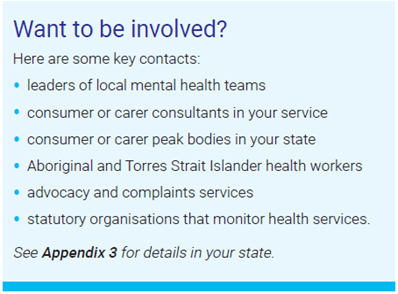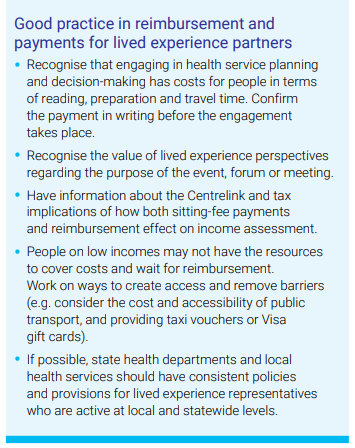Getting engaged
There are many ways in which consumers, carers, families and kinship groups can become involved in, and contribute to, conversations about safety and quality that lead to improved services.
Through your own lived experience, you are likely to know about a range of key issues and areas of service that could be improved. You may have talked to clinicians and service leaders about how your own care could be improved— for example, with better communication and coordination. You may have suggested changes to medicines, reported issues, complimented the service or made a complaint without fear of retribution. You may have written to the service or used a feedback form for voicing your thoughts.
Some services already take responsibility for actively promoting and recruiting consumers and carers to participate in service planning and governance structures.
Getting involved in service planning or governance
Many consumers, carers, families and kinship groups become active in assisting others. This can occur in inpatient units, through support groups or organisations, and through groups of consumers, carers, families and kinship groups. Getting involved in the decision-making in public mental health services is an extension of this helping role.
Many people talk about wanting to improve services for others and make sure others don’t have to go through difficult experiences. You can share what you have learned so that others may benefit.
- • Talk to your clinician or peer worker about ways of becoming involved— ask about the ‘partnering with consumer and carer activities’ of the service.
- • Talk to the consumer adviser or complaints manager at the hospital or health service. How to contact these people should be advertised throughout the service.
- • Ask to speak to a member of the quality improvement team . Members of this team should be aware of activities for partnering with consumers and carers.
- • Ask any of these people how you can communicate your suggestions for improving the service to decision makers, or how to become involved in decision-making.
- • Ask if you can complete a Your Experience of Service (YES) survey and a Care Experience of Services (CES) survey.4 These surveys should be available Australia-wide in public services, and offered to consumers and carers using a service.
- • Ask if any local mental health services, health networks, health departments or national organisations provide information or newsletters you can subscribe to.
- • Ask if you can be put on a contact database or membership register that distributes information about reforms in mental health care, and sends invitations to consultation meetings and forums.
There are other ways you can learn about what is happening locally:
- • Talk with other people with lived experience about issues you share, common concerns, and ways of communicating your concerns to service leaders. You could do this at a service, in a support group or over a coffee.
- • Talk with Elders or health leaders in your family and kinship groups , or with health leaders in an Aboriginal Community Controlled Health Service.
- • Identify your state’s peak consumer or carer organisation, and contact this organisation.
Through these contacts, you can get information about a range of events and projects that may interest you. Subscribing to newsletters or being on membership registers will help you learn about consultation meetings. At these public meetings, the service will ask people to share their thoughts and perspectives about change. Consumer and carer organisations also hold these meetings. You usually need to RSVP to these events through email or by phone.
Many health services have consumer, carer and community advisory groups that play an important part in improving safety and quality. Local health networks and health departments advertise for these consumer or carer adviser positions. These are positions or roles for being a part of project groups or committees that work on service improvement. Usually, positions require you to write an application or an expression of interest.
Examples of partnership
Here are some examples of the ways in which consumers, carers, families, kinship groups and service providers can work together.
- • A health service establishes an overview committee for mental health safety and quality to monitor the outcomes of the regional mental health services. It creates adviser positions on the committee for two consumers and two carers with lived experience. The committee reviews critical incidents, the Your Experience of Service surveys and other data about trends to identify issues. It makes recommendations to executive leaders.
- • A statewide consumer organisation runs a series of consultation meetings before writing a submission to the state government’s review of mental health legislation and consumer rights. Several multicultural welfare groups, disability advocates, and many consumers and carers are invited to the meeting.
- • A Local Health Network has a Consumer and Community Council that reports to the senior executive of the health service. Two council members are leaders in mental health lived experience. Two members are Aboriginal and Torres Strait Islander representatives who connect the council activity to local networks. The council also has members with lived experience from other health areas.
- • A Primary Health Network invites local people with lived experience to be part of the 6-month co-production process for developing ideas about how to commission primary mental health services for the regional population. It also invites community advisers from Aboriginal and Torres Strait Islander groups and LGBTIQ+ networks to partner in the process. These members work with service providers to formulate the quality standards and consumer engagement expected of the organisations that apply for funding to provide the services.

The broader aims of engagement: partnerships and co-production
The above examples are taken from projects occurring in various cities and regions around Australia. They are part of a commitment to the fundamental belief that mental health services must be designed, planned, monitored and evaluated via partnerships between consumers and carers using the service, the clinicians and peer workers who directly provide the services, and the service leaders.
Lived experience leaders and advisers play vital roles in communicating aspects of experience that can be overlooked or assumed by services providers. This experience might relate to community concerns or issues, accessibility, barriers, perspectives about medicines and treatment, preferred staff behaviours and standards, gaps in services, and wider impacts of the service on consumers and families. Lived experience leaders provide a non-institutional perspective that reflects information and experience within community networks about the value of the service in people’s lives.
The expectations of partnership are built into the National Safety and Quality Health Service (NSQHS) Standards, and are best reflected in the Clinical Governance Standard and the Partnering with Consumers Standard. Table 1 provides a summary of the actions that public and private health services need to demonstrate regarding partnership under the NSQHS Standards. Similar expectations are reflected in the National Mental Health Service Standards and various workforce standards.
To achieve the aim of partnership, leaders in lived experience must be engaged in all decision-making forums within the mental health service. This process must be supported and systematic, and recognise the value of lived experience perspectives alongside clinical and financial perspectives and the perspectives of leaders in other health sectors. Many local health services have frameworks for consumer, carer and community engagement to oversee actions that the service commits to.
Co-production is a valuable approach for bringing people together in ways that ensure that lived experience perspectives are heard, valued and incorporated into planning, implementation and evaluation. The focus is on setting agendas for change together and identifying ways in which diverse voices can be involved in decision- making processes. Co-production deliberately sets out to create a culture that values all expertise and knowledge, particularly the expertise and knowledge of the people who are most affected by the problem and the solution. Lived experience leaders often co-chair or co-facilitate meetings. The approach aims to equal basis of power sharing and influence, which often means that consumers take a leadership role in the process with clinicians and other leaders being contributors and learners.
See more examples in Section 4 Working together.
Table 1: Actions relating to partnership in the Clinical Governance Standard and Partnering with Consumers Standard of the National Safety and Quality Health Service Standards
Clinical Governance Standard
| Action | Summary of required actions by the health service |
| 1.1 | Provide leadership to establish culture of safety and quality and a culture of partnership with consumers and carers |
| 1.2 | Ensure that the safety and quality priorities address specific health needs of Aboriginal and Torres Strait Islander people |
| 1.4 | Implement and monitor strategies to meet the health service’s safety and quality priorities for Aboriginal and Torres Strait Islander people |
| 1.8 | Involve consumers and the workforce in the review of safety and quality performance and systems |
| 1.13 | Use processes to encourage regular feedback from consumers, carers and families about their experiences and outcomes of care, and use this information to improve safety and quality |
| 1.33 | Provide a welcoming environment that recognises the significance of cultural beliefs and practices of Aboriginal and Torres Strait Islander people |
Partnering with Consumers Standard
| 2.2 | Implement strategies that improve partnerships with consumers and carers |
Monitor and report on these strategies
| 2.9 | Involve consumers and carers in developing and reviewing the organisation’s health literacy products (e.g. health and services brochures, posters) |
| 2.11 | Involve consumers and carers in partnerships within governance, and in the design and review of health service programs and health care |
Seek to engage a range of consumers and carers that reflects the diversity of health service users and the local community
| 2.12 | Provide orientation, support and education to consumers and carers who are partnering in governance, design and review of health service programs |
| 2.13 | Work in partnership with Aboriginal and Torres Strait Islander communities to meet healthcare needs |
| 2.14 | Work in partnership with consumers and carers to bring their perspectives and experiences into workforce training and education |
Information you will need from service providers
If you are interested in being involved, attending a meeting, or becoming an adviser or representative, a range of information is available to help with your planning (see Table 2). Service leaders and managers must provide this information to help you prepare; the information must be available in printed form. There should also be a contact person to talk with.
Table 2: Information that service providers need to provide to help you engage
| Role | A clear statement about the role of people with lived experience. What is the nature of input and contributions to the group? |
| Purpose | A clear statement of the purpose of the group or event. What is being worked on and what is hoped for? What is the scope, or focus, of change? What information is shared? What is the time frame of the group? |
| Contact point | A contact person to talk to about the position. Often you need to talk through the purpose and consumer/carer roles in the group. Also, details should be provided on how the group functions and makes decisions. |
| Who's involved | Information about other roles in the group or project. Who else is involved? |
| Distrubution of papers | How will papers be handled? Information should be provided on hard copy availability, distribution, timelines for reading and preparation, printing support. |
| Supports available | Information about accessibility and inclusion, and available supports. A contact person should be listed. |
| Inclusive values | Is the group informed by lived experience values? Are other members aware of, and skilled in, working with lived experience perspectives? Is there a culture of inclusion? |
| History and handover | A handover about the history and current business of the group. For example, how long has it been running? |
| Meeting dates and venues | Information about meeting dates, times and venues; the length of your involvement; and access and any supports available to help you travel to the meeting. |
| Payment and reimbursement | Are there sitting fees? Is there recognition of, and reimbursement for, travel and prereading? How are payments organised and delivered to you? A contact person should be available to discuss these aspects. |
| Decision-making | Information about the organisational structure of the group—how it links and reports to other decision makers in the health service. |
| Clearances | Whether any clearances are required (e.g. national police check or confidentiality agreement). |
Identifying your knowledge and skill set
If you have received the above information and you are interested in exploring further, one thing to consider is how your knowledge and skills align with the purpose of the event or group.
It’s good to explore the issues you feel are most important from both your perspective and your network’s perspective. For example, you might be interested in joining a committee looking at mental health medicines. So you could consider the issues around consumer experience of medicines in terms of your own views and experience, and those you know are common among consumer circles. Issues might include choice, control, access to information, experience of side effects, adverse events, communication with clinicians, and involvement in treatment planning.
Before joining a group, also consider your experience and the level at which you want to be involved. Committees and consultations occur at different levels: some focus on the local service area, whereas others are connected to the state departments of health. It’s good to talk with an experienced lived experience leader about your interests and your expertise, which can help you decide whether you are comfortable in applying.
Local services and peak consumer groups should offer training to help you understand the skills and knowledge involved in becoming active. There should also be pathways for people who want to offer their views and experience without needing experience or training in being a representative. See Section 8 for more on training.
Cultural considerations for consultation and partnerships
Many people from Aboriginal and Torres Strait Islander communities, and culturally and linguistically diverse communities are aware of existing community leaders and services that play a role in representing key health issues in the community. There are often cultural protocols about who can speak about key issues or can consult within kinship groups. If you are interested in being a lived experience adviser in Aboriginal and Torres Strait Islander mental health, ensure that service providers are aware that you may need to speak with Elders and leaders in the community first. Service providers should also approach the local Aboriginal Community Controlled Health Service to discuss the various ways to make and strengthen partnerships, and who to approach regarding lived experience roles.

Use of information and data: privacy and informed consent
The information used in safety and quality discussions often comes from within the service. Numerous privacy and consent issues are involved. Public health services have information systems into which clinicians and managers enter data. This data includes information about critical incidents and both complaints and compliments. The information often refers to specific consumers of the service and the clinicians involved.
Sometimes critical incidents are examined by safety and quality committees. Therefore, both clinical and lived experience committee members need to understand the confidentiality of this information.
In addition, confidential information about a consumer’s experience is often shared during inpatient inspections or when ‘listening posts’ are set up to hear from consumers and carers using a service. In this case, the lived experience adviser needs to understand that consumers reporting their experience must consent to sharing of the information within the service for the purpose of improving quality.
On many occasions, safety and quality work involves looking at generalised data about service trends. An example would be the numbers of complaints and the categories of complaints, and whether these are being resolved. Another might be looking at the rates of seclusion and restrictive practices in the service and making recommendations about how to reduce and eliminate these.





